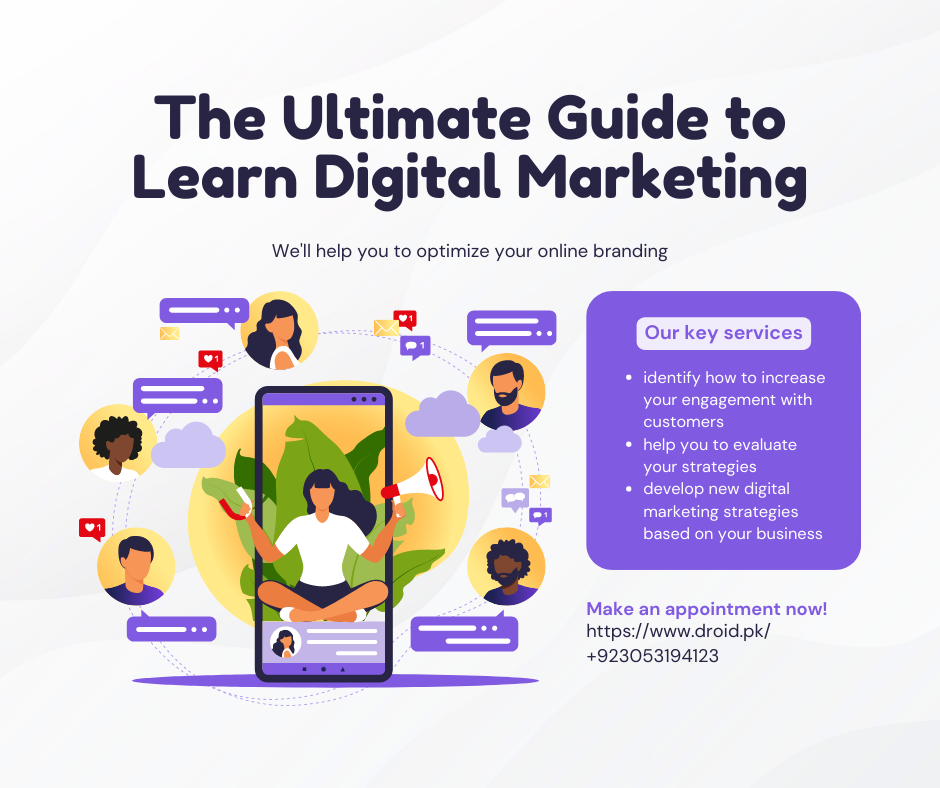
FREE Online Resources to Learn Digital Marketing
Share
Table of Contents
- Introduction: The Importance of Digital Marketing
- Understanding the Basics: Building a Strong Foundation
- Website Optimization: Creating an Effective Online Presence
- Content Marketing: Engaging and Attracting Your Audience
- Search Engine Optimization (SEO): Getting Found on the Web
- Social Media Marketing: Harnessing the Power of Social Networks
- Pay-Per-Click (PPC) Advertising: Driving Targeted Traffic
- Email Marketing: Nurturing Relationships and Boosting Conversions
- Influencer Marketing: Leveraging Digital Influencers for Growth
- Video Marketing: Captivating Audiences through Visual Content
- Mobile Marketing: Reaching Customers on the Go
- Data Analytics: Measuring and Optimizing Your Marketing Efforts
- Conversion Rate Optimization (CRO): Turning Visitors into Customers
- Online Advertising: Maximizing Reach and ROI
- Future Trends in Digital Marketing: Staying Ahead in a Dynamic Landscape
Introduction: The Importance of Digital Marketing
In today's fast-paced and highly connected world, digital marketing has become an essential strategy for businesses of all sizes. Whether you're a small startup or a multinational corporation, having a strong online presence and effectively reaching your target audience is crucial for success. However, navigating the ever-changing digital landscape can be challenging without the right knowledge and resources. That's where this book comes in.
"FREE Online Resources to Learn Digital Marketing" is your comprehensive guide to mastering the key aspects of digital marketing without breaking the bank. In this book, we will explore various free resources available on the internet that can equip you with the skills and knowledge needed to excel in the digital marketing realm. From website optimization to content marketing, SEO to social media marketing, and beyond, each chapter will delve into a specific topic, providing detailed information, practical tips, and recommended online resources.
Chapter 1: Understanding the Basics: Building a Strong Foundation
To kickstart your digital marketing journey, it's crucial to lay a solid foundation by understanding the basics. In this chapter, we will explore the fundamental concepts and principles that underpin digital marketing. Topics covered will include:
- Definition and scope of digital marketing
- Benefits and advantages of digital marketing over traditional marketing
- The buyer's journey and the importance of customer-centric marketing
- Identifying target audience and buyer personas
- Setting SMART goals for your digital marketing efforts
- Understanding key performance indicators (KPIs) and metrics to measure success
By grasping these foundational elements, you'll be better equipped to navigate the complexities of digital marketing and make informed decisions that drive results.
Chapter 2: Website Optimization: Creating an Effective Online Presence
In today's digital age, your website serves as the virtual storefront for your business. It's essential to optimize your website to provide a seamless user experience and drive conversions. In this chapter, we will explore the key components of website optimization, including:
- Website design and layout best practices
- User experience (UX) optimization
- Mobile responsiveness and optimization for different devices
- Search engine optimization (SEO) techniques for improved visibility
- Conversion rate optimization (CRO) strategies to maximize conversions
- Web analytics tools to track and analyze website performance
By implementing the strategies and techniques discussed in this chapter, you'll be able to create an effective online presence that captivates visitors and drives business growth.
Chapter 3: Content Marketing: Engaging and Attracting Your Audience
Content marketing is a powerful strategy for building brand awareness, establishing thought leadership, and nurturing customer relationships. In this chapter, we will delve into the world of content marketing, covering the following topics:
- Creating a content marketing strategy
- Content ideation and creation
- Effective storytelling and engaging writing techniques
- Content distribution and promotion channels
- Content curation and repurposing
- Measuring content marketing success through relevant metrics
By harnessing the power of compelling and valuable content, you can attract, engage, and retain your target audience, ultimately driving business growth.
Chapter 4: Search Engine Optimization (SEO): Getting Found on the Web
Search engine optimization (SEO) is essential for improving your website's visibility on search engines and driving organic traffic. In this chapter, we will explore the various aspects of SEO, including:
- Keyword research and optimization
- On-page SEO techniques
- Off-page SEO strategies, including link building
- Technical SEO considerations
- Local SEO optimization for location-based businesses
- SEO analytics and tracking
By optimizing your website for search engines, you can increase your online visibility, attract relevant traffic, and generate valuable leads and conversions.
Chapter 5: Social Media Marketing: Harnessing the Power of Social Networks
Social media platforms have revolutionized the way we connect, communicate, and consume information. In this chapter, we will dive into social media marketing and its significance for businesses. Key topics covered will include:
- Choosing the right social media platforms for your business
- Developing a social media strategy and content calendar
- Creating engaging social media posts and visuals
- Growing and nurturing your social media community
- Social media advertising and targeting options
- Social media analytics and measuring performance
By leveraging the power of social media, you can amplify your brand's reach, engage with your target audience, and drive meaningful interactions and conversions.
Chapter 6: Pay-Per-Click (PPC) Advertising: Driving Targeted Traffic
Pay-per-click (PPC) advertising offers a highly targeted approach to reaching your desired audience and driving qualified traffic to your website. In this chapter, we will explore the world of PPC advertising, including:
- Understanding the different PPC advertising platforms (Google Ads, Facebook Ads, etc.)
- Setting up PPC campaigns and ad groups
- Keyword research and targeting
- Writing compelling ad copy and creating effective landing pages
- Bid management and budget optimization
- Tracking and analyzing PPC campaign performance
By mastering the art of PPC advertising, you can ensure that your ads are displayed to the right audience at the right time, maximizing your return on investment (ROI).
Chapter 7: Email Marketing: Nurturing Relationships and Boosting Conversions
Email marketing remains one of the most effective channels for nurturing leads, retaining customers, and driving conversions. In this chapter, we will explore the strategies and tactics for successful email marketing campaigns, including:
- Building an email subscriber list
- Crafting personalized and targeted email content
- Designing visually appealing and mobile-responsive email templates
- Automation and segmentation for tailored email campaigns
- A/B testing and optimizing email performance
- Email deliverability and compliance with anti-spam regulations
By implementing effective email marketing strategies, you can establish strong customer relationships, drive repeat purchases, and boost your overall marketing efforts.
Chapter 8: Influencer Marketing: Leveraging Digital Influencers for Growth
Influencer marketing has emerged as a powerful strategy for tapping into the trust and authority of influential individuals in your industry. In this chapter, we will explore the world of influencer marketing, including:
- Identifying relevant influencers in your niche
- Establishing meaningful relationships with influencers
- Co-creating content and campaigns with influencers
- Measuring the impact and ROI of influencer marketing
- Avoiding common pitfalls and challenges in influencer collaborations
- Tools and platforms for managing influencer campaigns
By harnessing the power of influencers, you can extend your brand's reach, build credibility, and drive targeted engagement and conversions.
Chapter 9: Video Marketing: Captivating Audiences through Visual Content
Video has become an increasingly popular and engaging format for content consumption. In this chapter, we will explore the world of video marketing, covering the following topics:
- The importance of video in digital marketing
- Creating compelling video content
- Video optimization for different platforms (YouTube, social media, etc.)
- Video storytelling techniques
- Video editing and production tips
- Measuring video marketing success through analytics
By incorporating video marketing into your digital strategy, you can captivate audiences, deliver your brand message effectively, and drive higher levels of engagement.
Chapter 10: Mobile Marketing: Reaching Customers on the Go
With the widespread use of smartphones, mobile marketing has become an integral part of any comprehensive digital marketing strategy. In this chapter, we will explore the world of mobile marketing, including:
- Mobile app marketing strategies
- Mobile website optimization
- SMS marketing and push notifications
- Location-based marketing and geotargeting
- Mobile advertising options
- Mobile analytics and tracking
By optimizing your marketing efforts for mobile devices, you can connect with your audience anytime, anywhere, and provide seamless user experiences.
Chapter 11: Data Analytics: Measuring and Optimizing Your Marketing Efforts
Data analytics plays a vital role in understanding the performance of your digital marketing campaigns and making data-driven decisions. In this chapter, we will explore the world of data analytics, including:
- Key metrics and KPIs for measuring marketing performance
- Web analytics tools and platforms (Google Analytics, etc.)
- Data visualization techniques
- Conversion tracking and attribution modeling
- A/B testing and experimentation
- Creating actionable insights from data
By harnessing the power of data analytics, you can gain valuable insights into your marketing efforts, optimize campaigns for better results, and drive continuous improvement.
Chapter 12: Conversion Rate Optimization (CRO): Turning Visitors into Customers
Conversion rate optimization (CRO) focuses on maximizing the percentage of website visitors who take a desired action, such as making a purchase or submitting a lead form. In this chapter, we will explore the strategies and techniques for effective CRO, including:
- Conducting website audits and identifying conversion barriers
- A/B testing and experimentation for conversion optimization
- Optimizing landing pages and call-to-action (CTA) elements
- User experience (UX) optimization for improved conversions
- Personalization and targeting for better conversion rates
- Measuring and analyzing CRO performance
By optimizing your conversion funnel, you can increase the number of conversions and ultimately drive revenue growth for your business.
Chapter 13: Online Advertising: Maximizing Reach and ROI
Online advertising offers a variety of channels and formats to reach your target audience effectively. In this chapter, we will explore the world of online advertising, covering the following topics:
- Display advertising on websites and ad networks
- Search engine advertising (pay-per-click)
- Social media advertising (Facebook Ads, Instagram Ads, etc.)
- Native advertising and sponsored content
- Remarketing and retargeting campaigns
- Optimizing online ad campaigns for maximum ROI
By strategically planning and executing online advertising campaigns, you can maximize your reach, attract qualified leads, and generate a positive return on your advertising investment.
Chapter 14: Future Trends in Digital Marketing: Staying Ahead in a Dynamic Landscape
The digital marketing landscape is continually evolving, with new technologies and trends emerging at a rapid pace. In this chapter, we will explore some of the future trends and innovations in digital marketing, including:
- Artificial intelligence (AI) and machine learning
- Voice search and virtual assistants
- Augmented reality (AR) and virtual reality (VR)
- Chatbots and conversational marketing
- Personalization and hyper-targeting
- Privacy and data protection considerations
By staying informed and embracing these future trends, you can stay ahead of the competition and ensure your digital marketing strategies remain effective in a dynamic and ever-changing landscape.
Conclusion
"FREE Online Resources to Learn Digital Marketing" serves as your comprehensive guide to mastering the key aspects of digital marketing without breaking the bank. Each chapter provides detailed information, practical tips, and recommended online resources to help you acquire the knowledge and skills needed to excel in the digital marketing realm. Whether you're a business owner, a marketing professional, or an aspiring digital marketer, this book will empower you to leverage the power of digital marketing and drive success for your brand or organization. So, grab a cup of coffee, dive into the chapters that interest you the most, and embark on your journey to becoming a digital marketing expert.
